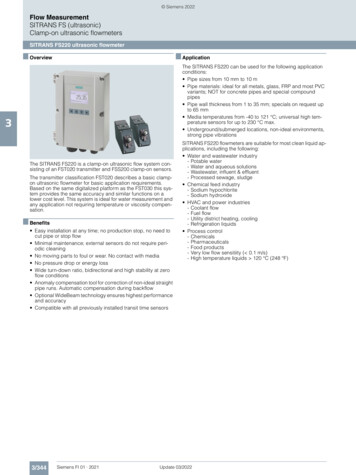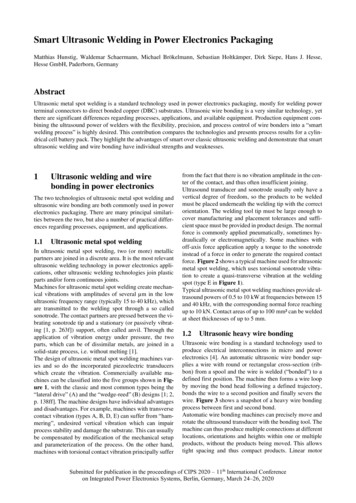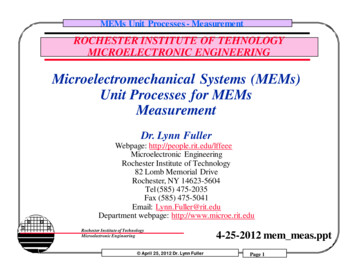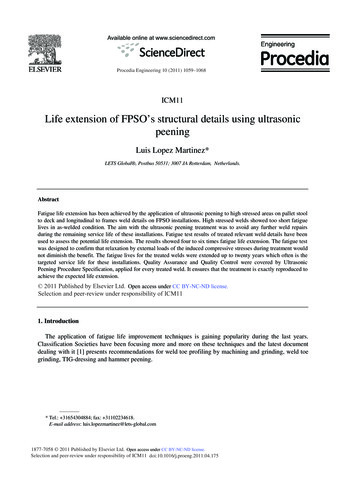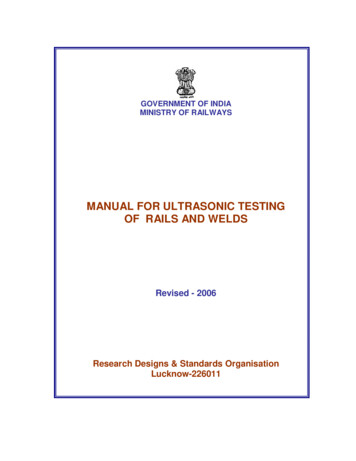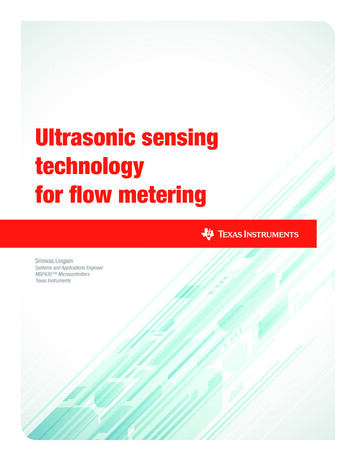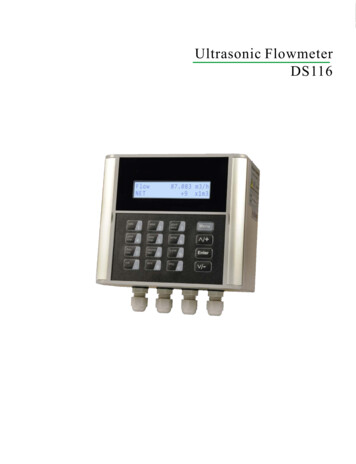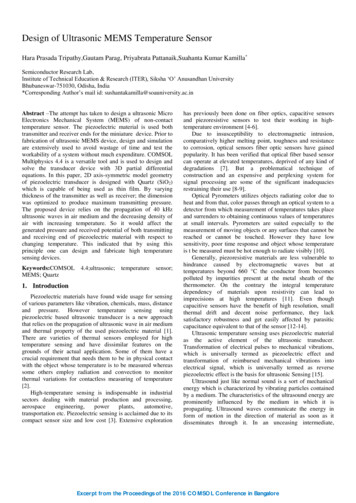
Transcription
Design of Ultrasonic MEMS Temperature SensorHara Prasada Tripathy,Gautam Parag, Priyabrata Pattanaik,Suahanta Kumar Kamilla*Semiconductor Research Lab,Institute of Technical Education & Research (ITER), Siksha ‘O’ Anusandhan UniversityBhubaneswar-751030, Odisha, India*Corresponding Author’s mail id: sushantakamilla@soauniversity.ac.inAbstract –The attempt has taken to design a ultrasonic MicroElectronics Mechanical System (MEMS) of non-contacttemperature sensor. The piezoelectric material is used bothtransmitter and receiver ends for the miniature device. Prior tofabrication of ultrasonic MEMS device, design and simulationare extensively used to avoid wastage of time and test theworkability of a system without much expenditure. COMSOLMultiphysics 4.4 is a versatile tool and is used to design andsolve the transducer device with 3D partial differentialequations. In this paper, 2D axis-symmetric model geometryof piezoelectric transducer is designed with Quartz (SiO2)which is capable of being used as thin film. By varyingthickness of the transmitter as well as receiver; the dimensionwas optimized to produce maximum transmitting pressure.The proposed device relies on the propagation of 40 kHzultrasonic waves in air medium and the decreasing density ofair with increasing temperature. So it would affect thegenerated pressure and received potential of both transmittingand receiving end of piezoelectric material with respect tochanging temperature. This indicated that by using thisprinciple one can design and fabricate high temperaturesensing devices.Keywords:COMSOLMEMS; Quartz4.4;ultrasonic;temperaturesensor;1. IntroductionPiezoelectric materials have found wide usage for sensingof various parameters like vibration, chemicals, mass, distanceand pressure. However temperature sensing usingpiezoelectric based ultrasonic transducer is a new approachthat relies on the propagation of ultrasonic wave in air mediumand thermal property of the used piezoelectric material [1].There are varieties of thermal sensors employed for hightemperature sensing and have dissimilar features on thegrounds of their actual application. Some of them have acrucial requirement that needs them to be in physical contactwith the object whose temperature is to be measured whereassome others employ radiation and convection to monitorthermal variations for contactless measuring of temperature[2].High-temperature sensing is indispensable in industrialsectors dealing with material production and tive,transportation etc. Piezoelectric sensing is acclaimed due to itscompact sensor size and low cost [3]. Extensive explorationhas previously been done on fiber optics, capacitive sensorsand piezoresistive sensors to test their working in hightemperature environment [4-6].Due to insusceptibility to electromagnetic intrusion,comparatively higher melting point, toughness and resistanceto corrosion, optical sensors fiber optic sensors have gainedpopularity. It has been verified that optical fiber based sensorcan operate at elevated temperatures, deprived of any kind ofdegradations [7]. But a problematical technique ofconstruction and an expensive and perplexing system forsignal processing are some of the significant inadequaciesrestraining their use [8-9].Optical Pyrometers utilizes objects radiating color due toheat and from that, color passes through an optical system to adetector from which measurement of temperatures takes placeand surrenders to obtaining continuous values of temperaturesat small intervals. Pyrometers are suited especially to themeasurement of moving objects or any surfaces that cannot bereached or cannot be touched. However they have lowsensitivity, poor time response and object whose temperatureis t be measured must be hot enough to radiate visibly [10].Generally, piezoresistive materials are less vulnerable tohindrance caused by electromagnetic waves but attemperatures beyond 660 C the conductor from becomespolluted by impurities present at the metal sheath of thethermometer. On the contrary the integral temperaturedependency of materials upon resistivity can lead toimprecisions at high temperatures [11]. Even thoughcapacitive sensors have the benefit of high resolution, smallthermal drift and decent noise performance, they lacksatisfactory robustness and get easily affected by parasiticcapacitance equivalent to that of the sensor [12-14].Ultrasonic temperature sensing uses piezoelectric materialas the active element of the ultrasonic transducer.Transformation of electrical pulses to mechanical vibrations,which is universally termed as piezoelectric effect andtransformation of reimbursed mechanical vibrations intoelectrical signal, which is universally termed as reversepiezoelectric effect is the basis for ultrasonic Sensing [15].Ultrasound just like normal sound is a sort of mechanicalenergy which is characterized by vibrating particles containedby a medium. The characteristics of the ultrasound energy areprominently influenced by the medium in which it ispropagating. Ultrasound waves communicate the energy inform of motion in the direction of material as soon as itdisseminates through it. In an unceasing intermediate,Excerpt from the Proceedings of the 2016 COMSOL Conference in Bangalore
performance of the ultrasound waves has meticulously beenlinked with equilibrium among the inertial forces and to thatof the elastic distortion. The travelling velocity of ultrasonicwaves relies on the material property and the form in whichmedium is and sporadically by the operating frequency.The sound field is affected by numerous aspects such asthe area over which the sound wave is generated, the speedsound waves in that particular medium and operatingfrequency of the waves. There are multiple points oforigination of ultrasonic waves across the surface of thetransducer.In this work the piezoelectric material used is quartz. It hasbeen tested and their performance with respect to temperaturehas been studied and reported. The charge generated by quartzcrystals is dependent on the cut and shape of the crystal [1617].The ultrasonic Micro-Electronics Mechanical Systems(MEMS) device technology is used to design an infinitesimaltransmitter and receiver. This technology has lately come toprominence as an alternative objective that entailsimprovements such as a substandard voltage requirement andflexible geometries. It also facilitates mixing of variousresonant frequencies for incorporation with the auxiliarymicroelectronics circuits [18]. The acoustic transducers systemrelies on the fundamental property of piezoelectric materials.Piezoelectric material is chosen on the grounds of largepiezoelectric coefficient, moderately larger dielectric constantand a high electromechanical coupling coefficient. Theseaforesaid strictures enable the propagation of ultrasonic wavesthrough the air medium. Quartz having a largeelectromechanical coupling coefficient has a broaderbandwidth [19].In order to curb the expenses and save time MEMSexperiments preferred to be done through a multidisciplinarysimulation platform to test the feasibility of the proposedsystem. The simulation platform used is COMSOLMultiphysics 4.4.2. Model Geometry of Ultrasonic TransducerCOMSOL Multiphysics is one of the few general-purposesoftware platforms which provide profusion accuracy, becauseof its advanced numerical methods, for simulation andmodelling of physics-based problems. It is intended for crossdisciplinary development of products with an integratedworkflow which not only solution based upon the 3D partialdifferential equation but also independent of the area ofapplication.Simulation using computers has now become a critical partof engineering and science as it saves time and resources. It isidyllic to employ a simulation platform that comprises theopportunity to add or remove any peripheral physical effect tothe designed model.For the design and simulation of ultrasonic temperaturesensor, the piezoelectric devices module was used in which aparameterized geometry was created along with addition ofPredefined materials to the model. The 2D axis-symmetricmodule of COMSOL Multiphysics 4.4 was utilized forsimulation of the device which is shown in Fig. 1(a) and alsothe 3D view of the model shown in Fig. 1(b). Relatively trivialpiezoelectric films are used as ultrasonic transmitter andreceiver. The air medium was considered as a cylindricalstructure of 5.2 cm diameter and 17.5 cm height. With changethe temperature, physical properties of the medium alsochanges which in turn impacts the propagation of ultrasonicwave.(a)(b)Figure 1. (a) 2D axis- symmetric model geometry showing thestructure of air medium as well as Quartz sample. (b) 3D View of themodel.3. Mathematical Analysis (Model)Ultrasound waves, like normal sound waves travel at acertain velocity in air medium. However, this velocity isdependent on temperature ( ) as the speed of sound ( )upsurges with increasing temperature [20]. Sound and heat areforms of kinetic energy. Therefore at elevated temperaturesmolecules have more energy as a result of which they vibraterapidly. Due to this faster vibration of molecules, energytransfer between molecules is faster which ultimately leads tofaster propagation of sound waves. The speed of sound in airmedium at room temperature is 343 m/s which fastercompared to that of speed of sound ( ) at 0 ºC which isequivalent to 331.3 m/s. This relation can be represented as(1)This can be written in terms of temperature:(2)According to ideal gas equation, density of air ( ) decreaseswith increase in temperature ( ), because the volume usuallybecomes greater which is shown in Fig. 2.For air medium obeying the 'perfect gas law' it isstraightforward. The fractional increase in density, at constantpressure ( ), is equal to fractional in temperature and shownin Fig. 3 [21]. This relation can be represented asExcerpt from the Proceedings of the 2016 COMSOL Conference in Bangalore
(3)This can be written in terms of temperature:(4)Here the medium and transducer size is kept constant.Also, a constant potential of 10 Volt is supplied to thetransmitter. The operating frequency of the transmitter isvaried from 20 KHz to 80 KHz. The optimum transmittingpressure and generated voltage obtained at optimizedfrequency of 40 KHz is shown in Fig. 4 . Hence the operatingfrequency is kept constant at 40 KHz.Here ‘ ’ is the ideal gas constant, which is also equivalent tothe product of the Boltzmann and the Avogadro constant.Figure 4. Frequency optimizationFigure 2. Speed of sound vs. Temperature4.2 Effect of sample width and thickness on fundamentalfrequencyAfter frequency optimization, the thickness of ultrasonicbased piezoelectric MEMS device is optimized to get besttransmitting pressure from transmitter side and best generatedvoltage from receiver end.At 40 KHz optimized frequency and a constant width of0.5475 cm the thickness of the transmitter and the receiver arevaried from 0.01 cm to 0.0885 cm.Figure 3. Air Density vs. Temperature4. Result & DiscussionFigure 5. Transmitter thickness optimizationThe acoustic wave produced by the piezoelectric ultrasonictransmitter propagates in the air medium to the receiver. Thegeometry of the medium significantly impacts the operatingfrequency for the transmitter and receiver.4.1 Frequency OptimizationThe transmitter is optimized for maximum transmittingpressure and shown in Fig. 5. The receiver is optimized formaximum generated voltage respectively as it can be seen inFig. 6. The transmitter thickness was fixed at 0.0705 cm andthe receiver at 0.0535 cm respectively.Excerpt from the Proceedings of the 2016 COMSOL Conference in Bangalore
4.3 Study of Receiving Pressure and Generated Voltage atthe Receiving EndThe axis-symmetrical geometry model of piezoelectrictransducers are maintained. But the medium density and speedof sound is varied with changing temperature while keepingthe shape and size intact.(5)Figure 8. (Receiving Pressure)-1 vs. TemperatureFigure 6. Receiver thickness optimizationWhen air density decreases as temperature increases, itresults in less particles in the medium. This decline in particledensity in turn affects the pressure received at the receiver.Fig. 7 shows that the receiving pressure drops when the airdensity decreases.As voltage sensitivity and receiver thickness are constantthe respective materials, generated potential is directlyproportional to receiving pressure which is clearly indicated ingraph in Fig. 9.Figure 9. (Receiving Pressure)-1 vs. Generated VoltageFigure 7. (Air Density)-1 vs. Receiving PressureIncreasing temperature impacts the air density negativelywhich ultimately leads in decline of pressure received at thereceiver. Fig. 8 clearly shows that the receiving pressure isinversely proportional to temperature.This voltage sensitivity of piezoelectric material variesfrom sample to sample. Generated Potential ( ) is solelydependent on piezoelectric material property such as voltagesensitivity of material (), receiving pressure ( ) andthickness of the receiver ( ).By comparing the plots from Fig. 7 through to Fig. 9, it isconcluded that the generated voltage at the receiver enddecreases as at the temperature rises, which can be seen in Fig.10. Hence temperature can be calculated from the generatedpotential.5. ConclusionThese ultrasonic transducers are designed by usingCOMSOL Multiphysics 4.4. From results of simulation it isfound that the less pressure generates as temperature increases.Quartz has quite significant pressure which can be utilized asan ultrasonic temperature sensor. However it squanders itspiezoelectric property around a temperature of 880 ºC.Excerpt from the Proceedings of the 2016 COMSOL Conference in Bangalore
8.9.10.11.Figure 10. Generated Voltage vs. TemperaturePiezoelectric materials with higher Curie temperature can beused for sensing even higher temperatures. The temperaturelimitation is not exclusively related to the piezoelectricmaterial’s Curie point and for successful design, all materialsused in the construction of a device need to be considered. Forexample, at higher temperatures, transducer delimitationensues due to strains caused by differential thermal expansion.This leads to degradation of performance and ultimate devicefailure. For contactless sensing of very high temperaturepiezoelectric technology is highly efficient.12.13.14.6. References1.2.3.4.5.6.7.Yasuchi Hayashi, Koji Numata and Kazutoshi Nishizawa,“Ultrasonic temperature measuring apparatus.’ U.S.Patent 5,360,268, issued November 1, (1994)Kienitz, Ulrich, and Christian Schiewe. "Method for thecontactless measuring of temperature with a multichannel pyrometer." U.S. Patent No. 4 p-821 219 (1989)Jiang, Xiaoning, Kyungrim Kim, Shujun Zhang, JosephJohnson, and Giovanni Salazar. "High-temperaturepiezoelectric sensing." Sensors 14, no. 1 (2013)Pulliam, Wade J., Patrick M. Russler, and Robert S.Fielder. "High-temperature high-bandwidth fiber opticMEMS pressure-sensor technology for turbine enginecomponent testing." In Environmental and IndustrialSensing, pp. 229-238. International Society for Optics andPhotonics (2002)Young, Darrin J., Jiangang Du, Christian A. Zorman, andWen H. Ko. "High-temperature single-crystal 3C-SiCcapacitive pressure sensor." Sensors Journal, IEEE 4, no.4,pp. 464-470 (2004)Li, Xin, Qin Liu, Shixin Pang, Kaixian Xu, Hui Tang, andChensong Sun. "High-temperature piezoresistive pressuresensor based on implantation of oxygen into siliconwafer." Sensors and Actuators A: Physical, no.179,pp.277-282 (2012)Wang, Jiajun, Bo Dong, Evan Lally, Jianmin Gong, MingHan, and Anbo Wang. "Multiplexed high temperaturesensing with sapphire fiber air gap-based extrinsic Fabry–15.16.17.18.19.20.21.Perot interferometers." Optics letters 35, no. 5, pp.619621 (2010)Nguyen, Linh Viet, Dusun Hwang, Sucbei Moon, DaeSeung Moon, and Youngjoo Chung. "High temperaturefiber sensor with high sensitivity based on core diametermismatch." Optics express 16, no. 15, pp.11369-11375(2008)Barrera, David, Vittoria Finazzi, Joel Villatoro, SalvadorSales, and Valerio Pruneri. "Packaged optical sensorsbased on regenerated fiber Bragg gratings for hightemperature applications." Sensors Journal, IEEE 12, no.1, pp.107-112 (2012)Ackerman, Sumner. "Automatic brightness pyrometers."U.S. Patent No. 3,264,931. August 9, (1966)Van Kampen, R. P., and R. F. Wolffenbuttel. "Modelingthe mechanical behavior of bulk-micromachined siliconaccelerometers." Sensors and Actuators A: Physical 64,no. 2, 137-150 (1998)Kasten, Klaus, Jörg Amelung, and Wilfried Mokwa."CMOS-compatible capacitive high temperature pressuresensors." Sensors and Actuators A: physical 85, no. 1,pp.147-152 (2000)Yazdi, Navid, Farrokh Ayazi, and Khalil Najafi."Micromachined inertial sensors." Proceedings of theIEEE 86, no. 8, pp.1640-1659 (1998)Zimmermann, L., J. Ph Ebersohl, F. Le Hung, J. P. Berry,F. Baillieu, P. Rey, B. Diem, S. Renard, and P. Caillat."Airbag application: a microsystem including a siliconcapacitive accelerometer, CMOS switched capacitorelectronics and true self-test capability." Sensors andActuators A: Physical 46, no. 1, pp.190-195 (1995)Aindow, Joseph. "Electrical coupling for piezoelectricultrasound detector." U.S. Patent No. 6,pp.094,988.(2000)Jaffe, H., and D. A. Berlincourt. "Piezoelectric transducermaterials."Proceedings of the IEEE 53.10, pp.1372-1386(1965)Jaffe, Bernard. Piezoelectric ceramics. Vol. 3. Elsevier(2012)Hara Prasada Tripathy, Priyabrata Pattanaik, SubratKumar Pradhan, and Sushanta Kumar Kamilla."Simulation Study of ZnO Based Ultrasonic MicroElectronics Mechanical Systems Model for BloodGlucose Level Measurement." Advanced Science Letters(ASP), Vol. 22, no. 2, pp.401-404 (2016)Lakin, M., J. Belsick, J. F. McDonald, and K. T.McCarron. "Improved bulk wave resonator couplingcoefficient for wide bandwidth filters." In UltrasonicsSymposium, 2001 IEEE, Vol. 1, pp. 827-831 (2001)Wong, George SK. "Speed of sound in standard air." TheJournal of the Acoustical Society of America, Vol. 79.5,pp.1359-1366 (1986)Perry, R.H. and Chilton, C.H., “Chemical Engineers’Handbook”, 5th ed., McGraw-Hill (1973)Excerpt from the Proceedings of the 2016 COMSOL Conference in Bangalore
COMSOL Multiphysics 4.4 is a versatile tool and is used to design and solve the transducer device with 3D partial differential equations. In this paper, 2D axis-symmetric model geometry of piezoelectric transducer is designed with Quartz (SiO, 2, ) which is capable of being used as thin film.
